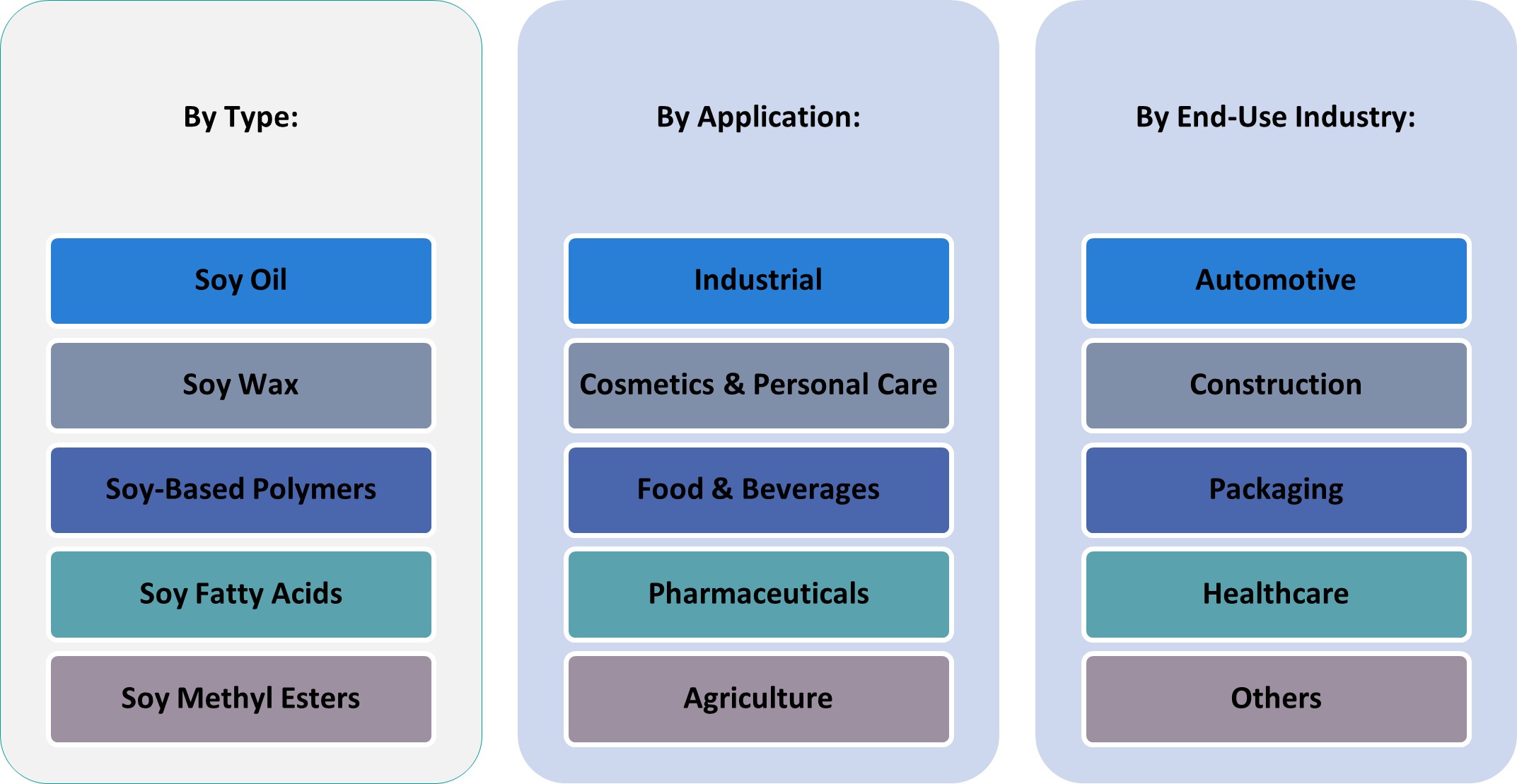CHAPTER NO. 1 : INTRODUCTION 19
1.1.1. Report Description 19
Purpose of the Report 19
USP & Key Offerings 19
1.1.2. Key Benefits for Stakeholders 19
1.1.3. Target Audience 20
1.1.4. Report Scope 20
CHAPTER NO. 2 : EXECUTIVE SUMMARY 21
2.1. Soy-Based Chemicals Market Snapshot 21
2.1.1. Indonesia Soy-Based Chemicals Market, 2018 – 2032 (USD Million) 22
CHAPTER NO. 3 : GEOPOLITICAL CRISIS IMPACT ANALYSIS 23
3.1. Russia-Ukraine and Israel-Palestine War Impacts 23
CHAPTER NO. 4 : SOY-BASED CHEMICALS MARKET – INDUSTRY ANALYSIS 24
4.1. Introduction 24
4.2. Market Drivers 25
4.2.1. Increasing demand for sustainable and biodegradable chemicals 25
4.2.2. Rising adoption of soy-based chemicals in industrial and personal care applications 26
4.3. Market Restraints 27
4.3.1. High production costs compared to petrochemical alternatives 27
4.4. Market Opportunities 28
4.4.1. Growing investments in R&D for advanced soy-based chemical formulations 28
4.5. Porter’s Five Forces Analysis 29
4.6. Buying Criteria 30
CHAPTER NO. 5 : IMPORT EXPORT ANALYSIS 31
5.1. Import Analysis by Indonesia 31
5.1.1. Indonesia Soy-Based Chemicals Market Import Volume/Revenue, By Indonesia, 2018 – 2023 31
5.2. Export Analysis by Indonesia 32
5.2.1. Indonesia Soy-Based Chemicals Market Export Volume/Revenue, By Indonesia, 2018 – 2023 32
CHAPTER NO. 6 : DEMAND SUPPLY ANALYSIS 33
6.1. Demand Analysis by Indonesia 33
6.1.1. Indonesia Soy-Based Chemicals Market Demand Volume/Revenue, By Indonesia, 2018 – 2023 33
6.2. Supply Analysis by Indonesia 34
6.2.1. Indonesia Soy-Based Chemicals Market Supply Volume/Revenue, By Indonesia, 2018 – 2023 34
CHAPTER NO. 7 : PRODUCTION ANALYSIS 35
7.1. Production Analysis by Indonesia 35
7.1.1. Indonesia Soy-Based Chemicals Market Production Volume/Revenue, By Indonesia, 2018 – 2023 35
CHAPTER NO. 8 : PRICE ANALYSIS 36
8.1. Price Analysis by Type 36
8.1.1. Indonesia Soy-Based Chemicals Market Price, By Type, 2018 – 2023 36
8.1.2. Indonesia Type Market Price, By Type, 2018 – 2023 36
CHAPTER NO. 9 : RAW MATERIALS ANALYSIS 37
9.1. Key Raw Materials and Suppliers 37
9.2. Key Raw Materials Price Trend 37
CHAPTER NO. 10 : MANUFACTURING COST ANALYSIS 38
10.1. Manufacturing Cost Analysis 38
10.2. Manufacturing Process 38
CHAPTER NO. 11 : ANALYSIS COMPETITIVE LANDSCAPE 39
11.1. Company Market Share Analysis – 2023 39
11.2. Value Chain Analysis 39
11.2.1. Indonesia Soy-Based Chemicals Market: Company Market Share, by Volume, 2023 40
11.2.2. Indonesia Soy-Based Chemicals Market: Company Market Share, by Revenue, 2023 41
11.2.3. Indonesia Soy-Based Chemicals Market: Top 6 Company Market Share, by Revenue, 2023 41
11.2.4. Indonesia Soy-Based Chemicals Market: Top 3 Company Market Share, by Revenue, 2023 42
11.3. Indonesia Soy-Based Chemicals Market Company Volume Market Share, 2023 43
11.4. Indonesia Soy-Based Chemicals Market Company Revenue Market Share, 2023 44
11.5. Company Assessment Metrics, 2023 44
11.5.1. Stars 44
11.5.2. Emerging Leaders 44
11.5.3. Pervasive Players 44
11.5.4. Participants 44
11.6. Start-ups /SMEs Assessment Metrics, 2023 44
11.6.1. Progressive Companies 44
11.6.2. Responsive Companies 45
11.6.3. Dynamic Companies 45
11.6.4. Starting Blocks 45
11.7. Strategic Developments 46
11.7.1. Acquisitions & Mergers 46
New Product Launch 46
Indonesia Expansion 46
11.8. Key Players Product Matrix 47
CHAPTER NO. 12 : PESTEL & ADJACENT MARKET ANALYSIS 48
12.1. PESTEL 48
12.1.1. Political Factors 48
12.1.2. Economic Factors 48
12.1.3. Social Factors 48
12.1.4. Technological Factors 48
12.1.5. Environmental Factors 48
12.1.6. Legal Factors 48
12.2. Adjacent Market Analysis 48
CHAPTER NO. 13 : SOY-BASED CHEMICALS MARKET – BY TYPE SEGMENT ANALYSIS 49
13.1. Soy-Based Chemicals Market Overview, by Type Segment 49
13.1.1. Soy-Based Chemicals Market Revenue Share, By Type, 2023 & 2032 50
13.1.2. Soy-Based Chemicals Market Attractiveness Analysis, By Type 51
13.1.3. Incremental Revenue Growth Opportunity, by Type, 2024 – 2032 51
13.1.4. Soy-Based Chemicals Market Revenue, By Type, 2018, 2023, 2027 & 2032 52
13.2. Soy Oil 53
13.3. Soy Wax 54
13.4. Soy-Based Polymers 55
13.5. Soy Fatty Acids 56
13.6. Soy Methyl Esters 57
CHAPTER NO. 14 : SOY-BASED CHEMICALS MARKET – BY APPLICATION SEGMENT ANALYSIS 58
14.1. Soy-Based Chemicals Market Overview, by Application Segment 58
14.1.1. Soy-Based Chemicals Market Revenue Share, By Application, 2023 & 2032 59
14.1.2. Soy-Based Chemicals Market Attractiveness Analysis, By Application 60
14.1.3. Incremental Revenue Growth Opportunity, by Application, 2024 – 2032 60
14.1.4. Soy-Based Chemicals Market Revenue, By Application, 2018, 2023, 2027 & 2032 61
14.2. Industrial 62
14.3. Cosmetics & Personal Care 63
14.4. Food & Beverages 64
14.5. Pharmaceuticals 65
14.6. Agriculture 66
CHAPTER NO. 15 : SOY-BASED CHEMICALS MARKET – BY END-USE INDUSTRY SEGMENT ANALYSIS 67
15.1. Soy-Based Chemicals Market Overview, by End-Use Industry Segment 67
15.1.1. Soy-Based Chemicals Market Revenue Share, By End-Use Industry, 2023 & 2032 68
15.1.2. Soy-Based Chemicals Market Attractiveness Analysis, By End-Use Industry 69
15.1.3. Incremental Revenue Growth Opportunity, by End-Use Industry, 2024 – 2032 69
15.1.4. Soy-Based Chemicals Market Revenue, By End-Use Industry, 2018, 2023, 2027 & 2032 70
15.2. Automotive 71
15.3. Construction 72
15.4. Packaging 73
15.5. Healthcare 74
15.6. Others 75
CHAPTER NO. 16 : SOY-BASED CHEMICALS MARKET – INDONESIA ANALYSIS 76
16.1. Type 76
16.1.1. Indonesia Soy-Based Chemicals Market Revenue, By Type, 2018 – 2023 (USD Million) 76
16.2. Indonesia Soy-Based Chemicals Market Revenue, By Type, 2024 – 2032 (USD Million) 76
16.3. Application 77
16.3.1. Indonesia Soy-Based Chemicals Market Revenue, By Application, 2018 – 2023 (USD Million) 77
16.3.2. Indonesia Soy-Based Chemicals Market Revenue, By Application, 2024 – 2032 (USD Million) 77
16.4. End-Use Industry 78
16.4.1. Indonesia Soy-Based Chemicals Market Revenue, By End-Use Industry, 2018 – 2023 (USD Million) 78
16.4.2. Indonesia Soy-Based Chemicals Market Revenue, By End-Use Industry, 2024 – 2032 (USD Million) 78
CHAPTER NO. 17 : COMPANY PROFILES 79
17.1. Wilmar International Limited 79
17.1.1. Company Overview 79
17.1.2. Product Portfolio 79
17.1.3. Swot Analysis 79
17.1.4. Business Strategy 80
17.1.5. Financial Overview 80
17.2. IOI Corporation Berhad 81
17.3. Godrej Agrovet Ltd. 81
17.4. PT SMART Tbk 81
17.5. KLK OLEO 81
17.6. Shandong Yuwang Industrial Co., Ltd. 81
17.7. Nihon Emulsion Co., Ltd. 81
17.8. Fuji Oil Holdings Inc. 81
17.9. Sime Darby Oils 81
17.10. Toyo Kagaku Co., Ltd. 81
List of Figures
FIG NO. 1. Indonesia Soy-Based Chemicals Market Revenue, 2018 – 2032 (USD Million) 22
FIG NO. 2. Porter’s Five Forces Analysis for Indonesia Soy-Based Chemicals Market 29
FIG NO. 3. Indonesia Soy-Based Chemicals Market Import Volume/Revenue, By Indonesia, 2018 – 2023 31
FIG NO. 4. Indonesia Soy-Based Chemicals Market Export Volume/Revenue, By Indonesia, 2018 – 2023 32
FIG NO. 5. Indonesia Soy-Based Chemicals Market Demand Volume/Revenue, By Indonesia, 2018 – 2023 33
FIG NO. 6. Indonesia Soy-Based Chemicals Market Supply Volume/Revenue, By Indonesia, 2018 – 2023 34
FIG NO. 7. Indonesia Soy-Based Chemicals Market Production Volume/Revenue, By Indonesia, 2018 – 2023 35
FIG NO. 8. Indonesia Soy-Based Chemicals Market Price, By Type, 2018 – 2023 36
FIG NO. 9. Raw Materials Price Trend Analysis, 2018 – 2023 37
FIG NO. 10. Manufacturing Cost Analysis 38
FIG NO. 11. Manufacturing Process 38
FIG NO. 12. Value Chain Analysis for Indonesia Soy-Based Chemicals Market 39
FIG NO. 13. Company Share Analysis, 2023 40
FIG NO. 14. Company Share Analysis, 2023 41
FIG NO. 15. Company Share Analysis, 2023 41
FIG NO. 16. Company Share Analysis, 2023 42
FIG NO. 17. Soy-Based Chemicals Market – Company Volume Market Share, 2023 43
FIG NO. 18. Soy-Based Chemicals Market – Company Revenue Market Share, 2023 44
FIG NO. 19. Soy-Based Chemicals Market Revenue Share, By Type, 2023 & 2032 50
FIG NO. 20. Market Attractiveness Analysis, By Type 51
FIG NO. 21. Incremental Revenue Growth Opportunity by Type, 2024 – 2032 51
FIG NO. 22. Soy-Based Chemicals Market Revenue, By Type, 2018, 2023, 2027 & 2032 52
FIG NO. 23. Indonesia Soy-Based Chemicals Market for Soy Oil, Revenue (USD Million) 2018 – 2032 53
FIG NO. 24. Indonesia Soy-Based Chemicals Market for Soy Wax, Revenue (USD Million) 2018 – 2032 54
FIG NO. 25. Indonesia Soy-Based Chemicals Market for Soy-Based Polymers, Revenue (USD Million) 2018 – 2032 55
FIG NO. 26. Indonesia Soy-Based Chemicals Market for Soy Fatty Acids, Revenue (USD Million) 2018 – 2032 56
FIG NO. 27. Indonesia Soy-Based Chemicals Market for Soy Methyl Esters, Revenue (USD Million) 2018 – 2032 57
FIG NO. 28. Soy-Based Chemicals Market Revenue Share, By Application, 2023 & 2032 59
FIG NO. 29. Market Attractiveness Analysis, By Application 60
FIG NO. 30. Incremental Revenue Growth Opportunity by Application, 2024 – 2032 60
FIG NO. 31. Soy-Based Chemicals Market Revenue, By Application, 2018, 2023, 2027 & 2032 61
FIG NO. 32. Indonesia Soy-Based Chemicals Market for Industrial, Revenue (USD Million) 2018 – 2032 62
FIG NO. 33. Indonesia Soy-Based Chemicals Market for Cosmetics & Personal Care, Revenue (USD Million) 2018 – 2032 63
FIG NO. 34. Indonesia Soy-Based Chemicals Market for Food & Beverages, Revenue (USD Million) 2018 – 2032 64
FIG NO. 35. Indonesia Soy-Based Chemicals Market for Pharmaceuticals, Revenue (USD Million) 2018 – 2032 65
FIG NO. 36. Indonesia Soy-Based Chemicals Market for Agriculture, Revenue (USD Million) 2018 – 2032 66
FIG NO. 37. Soy-Based Chemicals Market Revenue Share, By End-Use Industry, 2023 & 2032 68
FIG NO. 38. Market Attractiveness Analysis, By End-Use Industry 69
FIG NO. 39. Incremental Revenue Growth Opportunity by End-Use Industry, 2024 – 2032 69
FIG NO. 40. Soy-Based Chemicals Market Revenue, By End-Use Industry, 2018, 2023, 2027 & 2032 70
FIG NO. 41. Indonesia Soy-Based Chemicals Market for Automotive, Revenue (USD Million) 2018 – 2032 71
FIG NO. 42. Indonesia Soy-Based Chemicals Market for Construction, Revenue (USD Million) 2018 – 2032 72
FIG NO. 43. Indonesia Soy-Based Chemicals Market for Packaging, Revenue (USD Million) 2018 – 2032 73
FIG NO. 44. Indonesia Soy-Based Chemicals Market for Healthcare, Revenue (USD Million) 2018 – 2032 74
FIG NO. 45. Indonesia Soy-Based Chemicals Market for Others, Revenue (USD Million) 2018 – 2032 75
List of Tables
TABLE NO. 1. : Indonesia Soy-Based Chemicals Market: Snapshot 21
TABLE NO. 2. : Drivers for the Soy-Based Chemicals Market: Impact Analysis 25
TABLE NO. 3. : Restraints for the Soy-Based Chemicals Market: Impact Analysis 27
TABLE NO. 4. : Indonesia Soy-Based Chemicals Market Revenue, By Type, 2018 – 2023 36
TABLE NO. 5. : Key Raw Materials & Suppliers 37
TABLE NO. 6. : Indonesia Soy-Based Chemicals Market Revenue, By Type, 2018 – 2023 (USD Million) 76
TABLE NO. 7. : Indonesia Soy-Based Chemicals Market Revenue, By Type, 2024 – 2032 (USD Million) 76
TABLE NO. 8. : Indonesia Soy-Based Chemicals Market Revenue, By Application, 2018 – 2023 (USD Million) 77
TABLE NO. 9. : Indonesia Soy-Based Chemicals Market Revenue, By Application, 2024 – 2032 (USD Million) 77
TABLE NO. 10. : Indonesia Soy-Based Chemicals Market Revenue, By End-Use Industry, 2018 – 2023 (USD Million) 78
TABLE NO. 11. : Indonesia Soy-Based Chemicals Market Revenue, By End-Use Industry, 2024 – 2032 (USD Million) 78



















